- Influence of vermiculite and sintered fly ash in robustness and hardened properties of light weight self-compacting concrete
A. Anithaa,*, V.G. Kalpanab and P. Muthupriyac
aAssistant Professor, Department of Civil Engineering, Velalar college of Engineering and Technology, Erode
bAssistant Professor, Department of Civil Engineering, Coimbatore Institute of Technology, Coimbatore
cProfessor, Department of Civil Engineering, Dr. N.G.P. Institute of Technology, CoimbatoreThis article is an open access article distributed under the terms of the Creative Commons Attribution Non-Commercial License (http://creativecommons.org/licenses/by-nc/4.0) which permits unrestricted non-commercial use, distribution, and reproduction in any medium, provided the original work is properly cited.
The performance of Light Weight Self-Compacting Concrete (LWSCC) incorporated with Sintered Fly Ash and Vermiculite are investigated in this study. The robustness and hardened properties of the LWSCC is investigated at diverse proportioning rates where Cement, Fine Aggregate and Coarse Aggregate are replaced with Fly Ash (FA) (25%), Vermiculite (1-9%) and Sintered Fly Ash (SFA) (10-50%) respectively. The workability properties such as Filling ability, Passing ability, viscosity and the mechanical properties such as density, compressive strength, tensile strength, flexural strength, ultrasonic pulse velocity, acid and sulphate resistance were studied. The percentage loss in weight and loss in compressive strength due to Acid attack and Sulphate attack at the age of 28 days of LWSCC were observed by immersing in 10% of HNO3, magnesium sulphate and sodium sulphate solutions. Vermiculite with SFA considerably boosted the workability and mechanical properties of LWSCC mixes. The presence of lightweight aggregates reduced the strength loss caused by sodium and magnesium sulphate ions. A combination of 5% of Vermiculite and 30% of SFA resulted with the best robustness and hardened property of concrete
Keywords: Light weight self-compacting concrete, Sintered fly ash, Vermiculite, Robustness
Self-Compacting Concrete (SCC) was invented in Japan in the late 1980’s as a material that may flow through the congested reinforcing bars without compaction and significant separation which flow under its own weight [1]. SCC increases productivity, resulting in lesser construction time, facilitates the construction of densely packed and difficult-to-reach areas, improves in situ concrete quality, reduces noise- and vibration-related injuries, and aids in achieving higher surface quality [1]. One of the limitations of SCC is its high cost, due to the usage of huge amount of Portland cement and chemical admixtures. The usage of the industrial waste and industrial by-products as mineral admixtures is the easy way to lowering the cost of SCC [2]. Mineral admixtures reduce the heat of hydration and enhance rheological characteristics and prevent thermally-induced cracking in concrete [3, 4]. Lightweight concrete is made by introducing light-weight aggregates such as pumice, perlite, and vermiculite into the concrete mix having unit weight of range 80 to 900 kg/m3, or by incorporating air into the concrete mix [4, 6]. Lightweight concrete has several advantages over conventional concrete, such as low density, low heat conductivity and better thermal insulation, resulting in smaller cross sections of structural elements [5-7, 11]. Increased EPS content in the light weight concrete results in a considerable decrease in compressive strength [8]. The most obvious advantage of structural lightweight concrete is its reduced deadweight [9].
Vermiculite is a lightweight aggregate that helps with thermal insulation. Andhra Pradesh is the biggest producer of vermiculite, accounting for 72% of total output, with Rajasthan and Tamil Nadu accounting for the remaining 28%. Total output, including public and private sectors, is 2774 tonne [10]. It has a platey structure comparable to mica. When heated to temperatures ranging from 650 to 1000 °C for several expanded vermiculite, or up to 30 times its original volume through thin plate exfoliation. As a result, bulk density of vermiculite is less than 130 kg/m3 results in low strength, high shrinkage, high refractoriness, poor thermal conductivity and better thermal insulating property [7, 14, 15]. Vermiculite's chemical inertness makes it suitable for a wide range of thermal and acoustic insulations [12]. The chemical formula of vermiculite is (Mg,Ca)0.3–0.45 (H2O)n{(Mg,Fe, Al)3(Al,Si)4·O10(OH)} [13].
The usage of Sintered Fly Ash along with low water-binder ratio give high carbonation resistance and good quality of the concrete [14]. SCC has higher powder concentration (400-600 kg/m3) and higher cementitious paste content (34-40%) render it particularly prone to chemical assault. The interaction between the hydrates in cement pastes and dissolved chemicals in the alkali solution, such as sodium sulphate or magnesium sulphate will generate gypsum and ettringite resulted in concrete expansion, cracking, and degradation due to the reactivity of SO2 ions [15, 19]. It is reported that the sulphate resistance conferred by mineral admixtures, which are commonly used to improve the quality and durability of concrete [16]. Most of the researchers shows that the compatibility of lightweight aggregates in conventional concrete or the influence of any one type of light weight aggregate in the self-compacting concrete.
The present research focus mainly to develop the self-compacting concrete with Vermiculite and Sintered Fly Ash and also to investigate Filling ability, Passing ability, viscosity and the mechanical properties such as density, compressive strength, tensile strength, flexural strength, ultrasonic pulse velocity, acid and sulphate resistance. In this study the vermiculite is replaced at 1%, 3%, 5%, 7% and 9% for fine aggregate and Sintered Fly Ash at 10%, 20%, 30%, 40% and 50% for coarse aggregate. The combination 5% vermiculite with different replacement levels of Sintered Fly Ash also studied. This study helps to validate the usefulness of incorporating vermiculite and SFA for the development of Lightweight self-compacting concrete.
Materials
Ordinary Portland Cement (OPC) of grade 53 confirming to IS:12269 [17] is used in this study. Class F Fly Ash obtained from the Mettur Thermal Power plant, Tamilnadu, India is used as replacement for OPC. Table 1 shows the physical and chemical properties of cement and Fly Ash obtained from X-Ray Fluorescence test. M.Sand is used as fine aggregate and Crushed angular stone is used as coarse aggregate. Specific gravity and water absorption value are 2.74 and 5% for fine aggregate and 2.79, 0.5% for coarse aggregates respectively.
The exfoliated vermiculite shown in Fig. 1(a) is utilized in this investigation is obtained from Sri Ramamaruthi Vermiculite Mines, Andhra Pradesh, India. It belongs to Mica family with a Monoclinic crystal structure. It has high insulating capacity and it is used in ceramic applications. Another Light Weight Aggregate (LWA) namely Sintered Fly Ash aggregate (SFA) is obtained from Litagg Industries Private Limited, Ahmedabad, India. It is made from the sintering process of fly ash as per IS 9142 Part 2 [18]. It is a round pellet of size 8-12mm as shown in Fig. 1(b) with a bulk density 850 kg/m3 and bulk porosity of 35%. A new generation based modified Poly Carboxylic Ether (PCE) is used as a chemical admixture which conforms to IS 9103 [19] and ASTM C494 Type F [17]. It is reddish brown liquid having specific gravity of 1.08, pH is greater than or equal to 6 and solid contents not less than 32% by weight.
Mix Proportions
Totally Sixteen series of mix proportions were arrived as per IS 10262:2019 for the concrete grade of M30 shown in Table 2. The dosage of the SP is determined by using Marsh cone test.
In Specimen ID where CC, V, SFA denotes Control Concrete, Vermiculite and Sintered Fly Ash respectively. The numerical value represents the percentage of replacement of Fine aggregate and Coarse Aggregate in concrete. V5SFA with numerical value denotes combination of 5% vermiculite and SFA at different replacement percentages.
Methodology
The optimum dosage of the Super Plasticizer (SP) used in the SCC is determined by using Marsh cone test as per the standards of ASTM C939-97 [19] as shown in the Fig. 2(a). From Fig. 2(b) it is noted that the SP content is saturated after the dosage of 2.8%. Fig. 2(b) shows that the regression values satisfies and indicates the compatibility of dosage of admixtures with marsh cone flow time.
The cube specimens of 150 mm size are used to determine the density, compressive strength, ultrasonic pulse velocity, acid and sulphate resistance. The cylinder of height 300 mm and diameter 150 mm and prism of size 100 mm × 100 mm × 500 mm is used to determine tensile strength and flexural strength of the concrete respectively. As per EFNARC guidelines slump flow diameter, V-funnel time, J-Ring and T timings of the fresh LWSCC mixes were measured [20]. For acid and sulphate resistance test, the sample is immersed in HNO3, magnesium sulphate and sodium sulphate solutions of each 10% respectively at room temperature in accordance with the ASTM C1012-04 standard [21]. The sulphate solutions were replaced every four weeks to reduce the pH rise caused by the leaching of hydroxide ions from the concrete specimen.

|
Fig. 1 (a) Vermiculite, (b) Sintered Fly Ash. |

|
Fig. 2 (a) Marsh Cone test, (b) Relation between dosage of SP and Marsh cone flow time |
Properties of fresh concrete
All SCC combinations achieve adequate slump flow shown in Fig. 3(a) which is in the range of 630 mm-800 mm meet the EFNARC guidelines for SF2 and SF3. The slump flow time (T) for the Light Weight Self Compacting Concrete [LWSCC] to reach a diameter of 500 mm is more than 2 sec [21] for all mixes. The results shown in Fig. 4 clearly depicts that the increase in % of lightweight aggregates in SCC mixes reduces the spread in slump flow diameter and increases the time required to reach 500 mm circle [22].
The V-funnel test is used to assess the viscosity characteristics of the SCC mixes. Fig. 6 clearly shows that the LWA increases the V-funnel flowing time. This indicates that the viscosity of the SCC increases for all mixes. V-funnel time is within the permissible limits as per EFNARC guidelines (9 to 25 sec) (VF2) [21] and flowability is achieved without any segregation or blocking.
The J-ring test is used to assess the passing ability of the SCC by calculating the step height as shown in Fig. 3(b). When the LWA percentage increases the step height also increases.
From the Figs. 4, 5, 6 and 7, it is observed that increase in % of Vermiculite reduces the flowability. V5 and V5SFA50 mixes shows the same slump flow diameter values and it is 24.60% lesser value than control concrete [23]. The time taken to reach 500 mm diameter is higher in V9 mixes which is 63.76% higher than CC. The V-funnel flow time is decreased in SFA10, SFA20, and V5SFA10 and same as CC in V1, SFA30, and V5SFA20. The step height in J-ring test is 70.5% more in V9. The increase in vermiculite Percentage progressively decrease slump flow diameter and increase T500, V-funnel flow time and J-ring step height.
Properties of hardened concrete
It is observed from the test results that the compressive, tensile and flexural strength of LWSCC with vermiculite decreases when compared to CC, when the percentage replacement increases. This is because of high porous nature and low density of vermiculite.
The vermiculite is a low density and high porous aggregates, so it does not make any impact in strength aspects. Sintered Fly Ash is a structural light weight aggregate, its addition increases 7.5% of compressive strength, 12.6% of tensile strength and 8.3% of Flexural strength at 30% replacement. The combination of vermiculite with Sintered Fly Ash [24] considerably increases the mechanical properties of the SCC. The addition of 5% vermiculite with 30% SFA increases 8.89% of compressive strength, 8.53% of tensile strength and 7.69% of flexural strength as shown in Figs. 8, 9 and 10. SCC with Sintered Fly Ash and vermiculite change the micro-structural behavior of the concrete and improve the hydroxide and CSH gel formation and decrease the transition zone characteristics. The particles in the fly ash react with the cement and gain strength development at later ages due to the hydration process [25].
Fig. 11 shows the density of the all SCC mixes with lightweight aggregates. The density decreases as the vermiculite and Sintered Fly Ash content increased. This is because the density is a function of specific gravity, and a lightweight aggregate has a lower specific gravity than conventional aggregates and Sintered Fly Ash has a micro filler effect [26].
Table 3 shows the Ultra-sonic Pulse Velocity values at various replacement levels of LWA. Direct transmission of mechanical pulses is used to find the homogeneity of the concrete. When the percentage replacement of LWA increases the pulse velocity value decreases constantly. The porosity of the LWSCC leads to decrease in time taken by the pulses for transmission when comparing control concrete.
Statistical analysis
A statistical approach ANOVA used to predict relation between Compressive strength with tensile strength and flexural strength using variance. Regression analysis gives the mathematical relation between the Strength parameters. The linear regression equation is in the form of y = ax+b. R2 is the coefficient of determination used to predict correct fit. Fig. 12 and 13 shows that the relation between strength parameter at 28 days satisfies the regression values for best fit. The Significance F gives the reliability of the model. Table 4 and 5 shows the reliability of the model is less than 0.05, hence it is ok.
Acid and Sulphate attack
Weight and Compressive strength loss
Fig. 14 and 15 depicts the percentage of the weight loss and strength loss of LWSCC specimens immersed in HNO3, sodium sulphate and magnesium sulphate solutions of each 10%. The strength values are addressed in terms of strength loss to emphasize the damage caused to SCC mix by acid and sulphate attacks.
The percentage of weight loss increased and percentage of strength loss increased when comparing to control concrete as the replacement of LWA increased. The SFA50 and V9 clearly outperformed in terms of resistance to acid and sulphate attack respectively as shown in Fig. 14 and 15. The chemical interaction of sulphate ions as the aggressive agent and the aluminate component of cured cement paste causes sulphate attack on concrete [27]. If enough water is present, the interaction between these components creates ettringite and gypsum, causing the concrete to expand and break. When calcium hydroxide is depleted, the assault of magnesium ions to a lesser extent, sodium ions on C-S-H begins at the same time as the sulphate attack. This assault causes gypsum precipitation and C-S-H decalcification. Decalcification of C-S-H decreases its binding capacity and causes a loss of strength in concrete [28].
Fig. 15 shows the strength loss in control specimen is relatively high when compared to all the series in magnesium sulphate attack. The result is consistent with the findings of other researchers who determined that ettringite production had been the primary mechanism of degradation in the mixture that did not contain mineral admixtures Ettringite production is minimal in VSFA rich blends because it is rich in aluminium that is not accessible for reaction [29].
As a result, the VSFA series outperformed than all other series in that solution. The greater resistance of VSFA-containing mixes to sulphate attack is related to the pore refinement process, which occurs as a result of the conversion of lime formed during cement hydration into extra binding material through the lime pozzolana reaction. By densifying the transition zone and forming more calcium silicate hydrates, these pozzolanic elements help to improve the aggregate-paste connection [30].
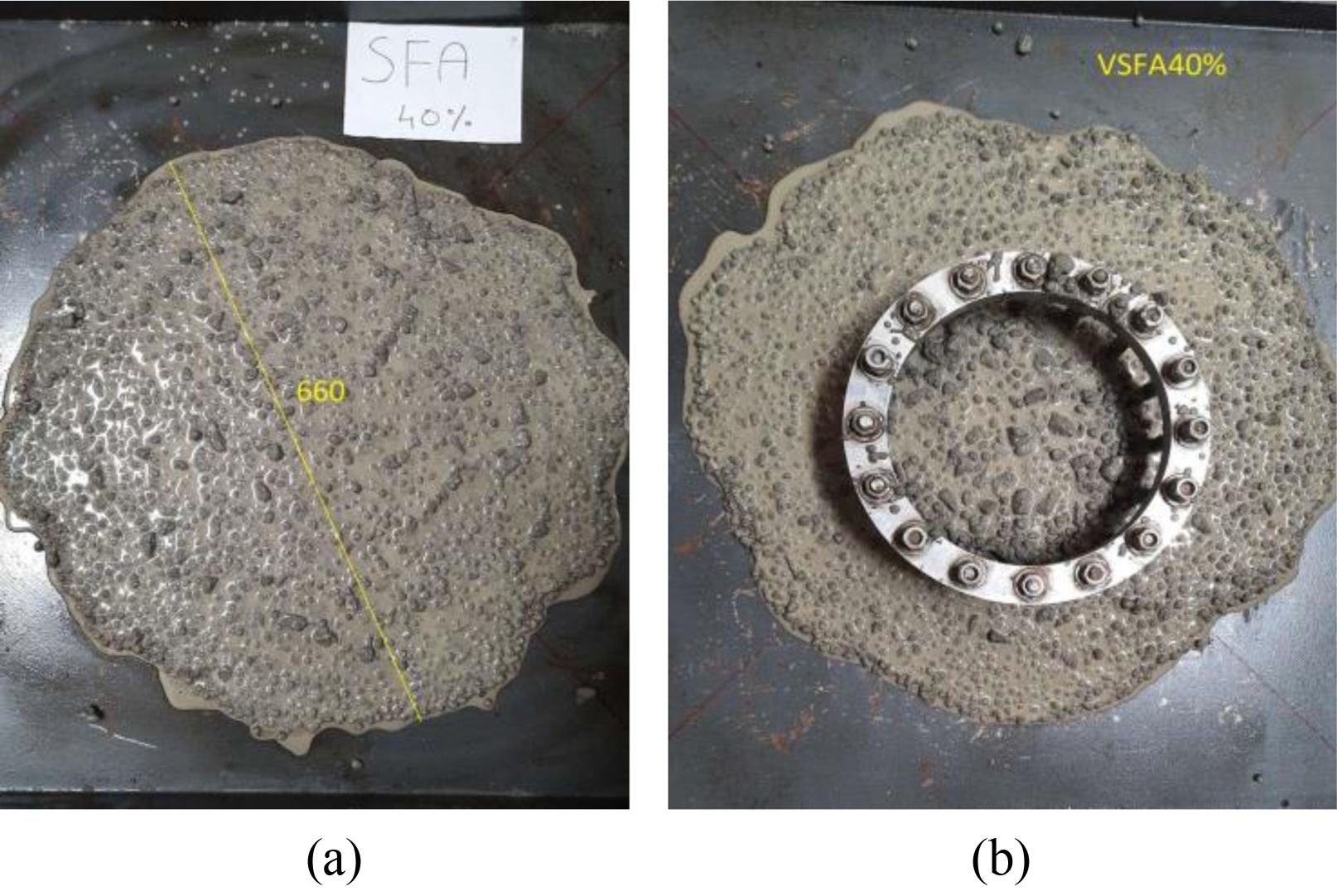
|
Fig. 3 (a) Slump Test, (b) J-Ring Test. |
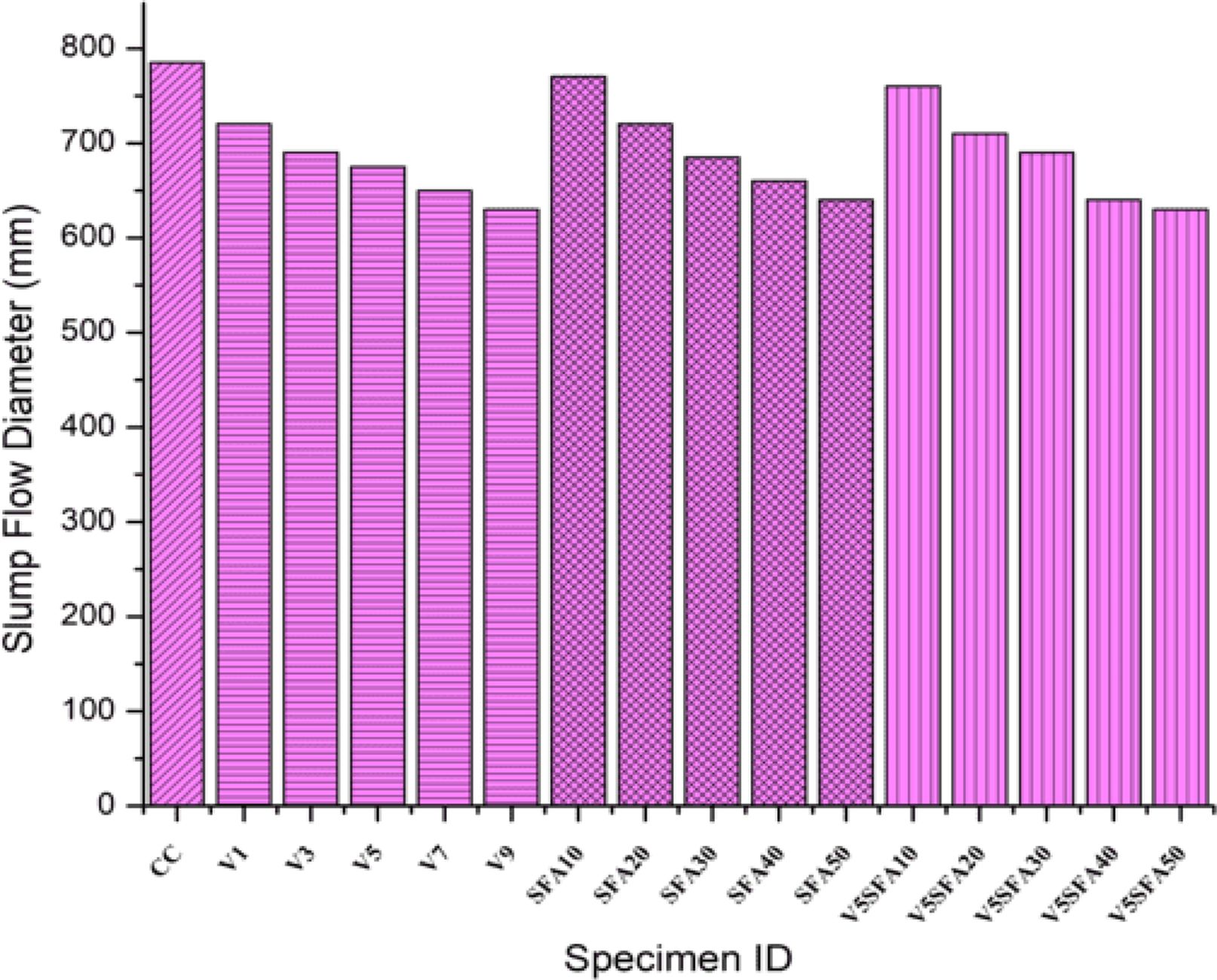
|
Fig. 4 Comparison of Slump flow test results for various mixes. |

|
Fig. 5 Comparison of T500 test results for various mixes. |

|
Fig. 6 Comparison of V Funnel flow test results for various mixes. |
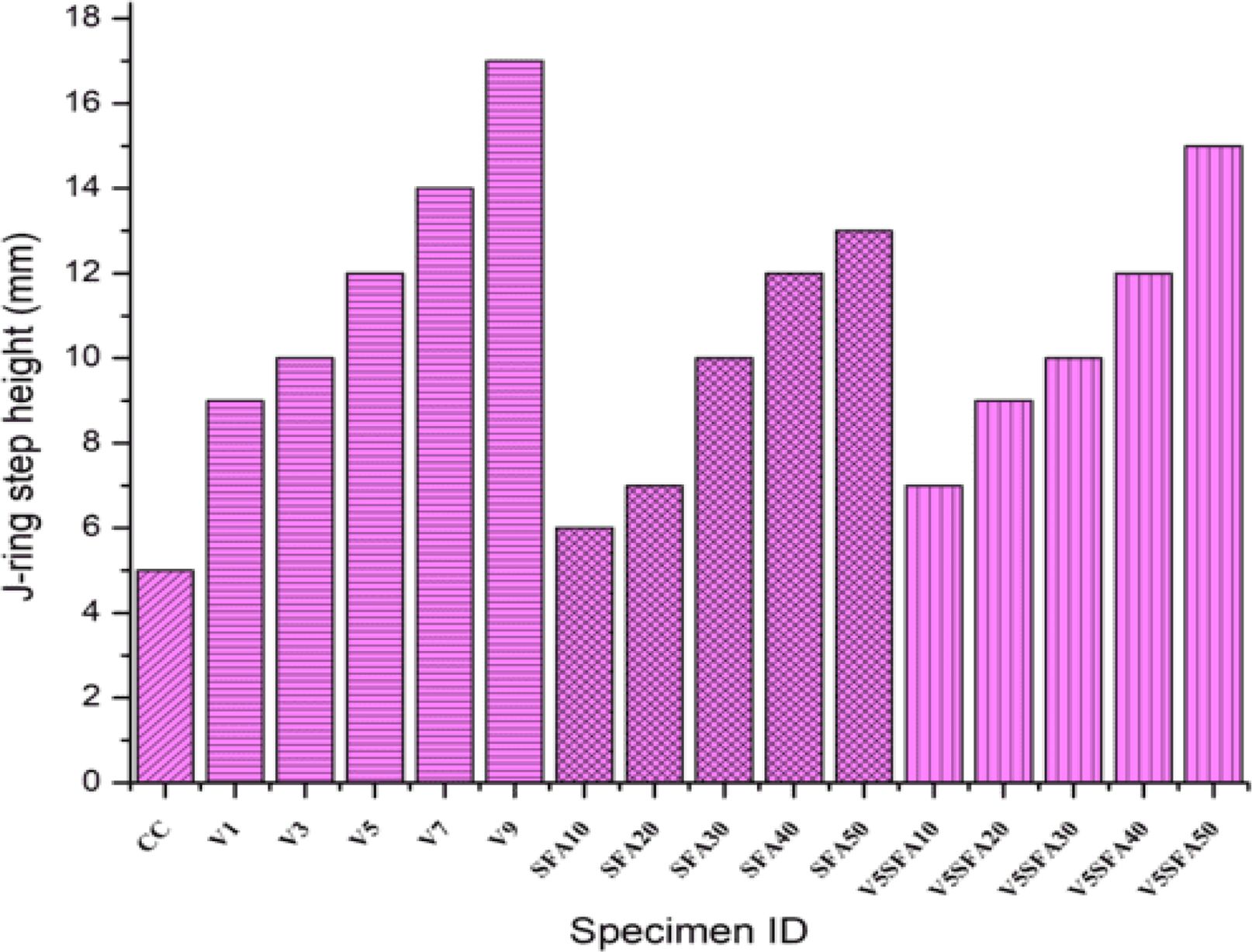
|
Fig. 7 Comparison of J-ring test results for various mixes |
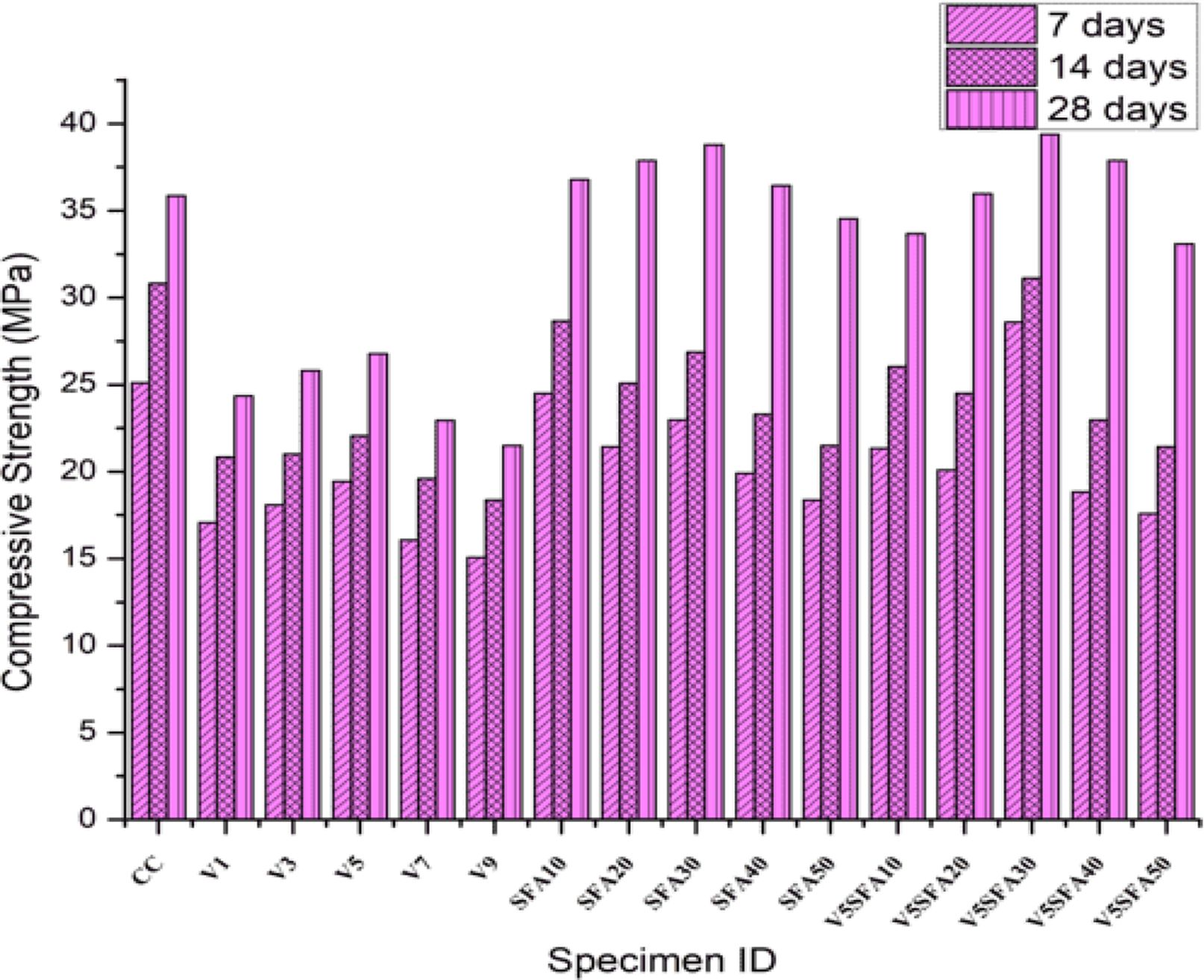
|
Fig. 8 Comparison of Compressive strength of concrete for various mixes. |
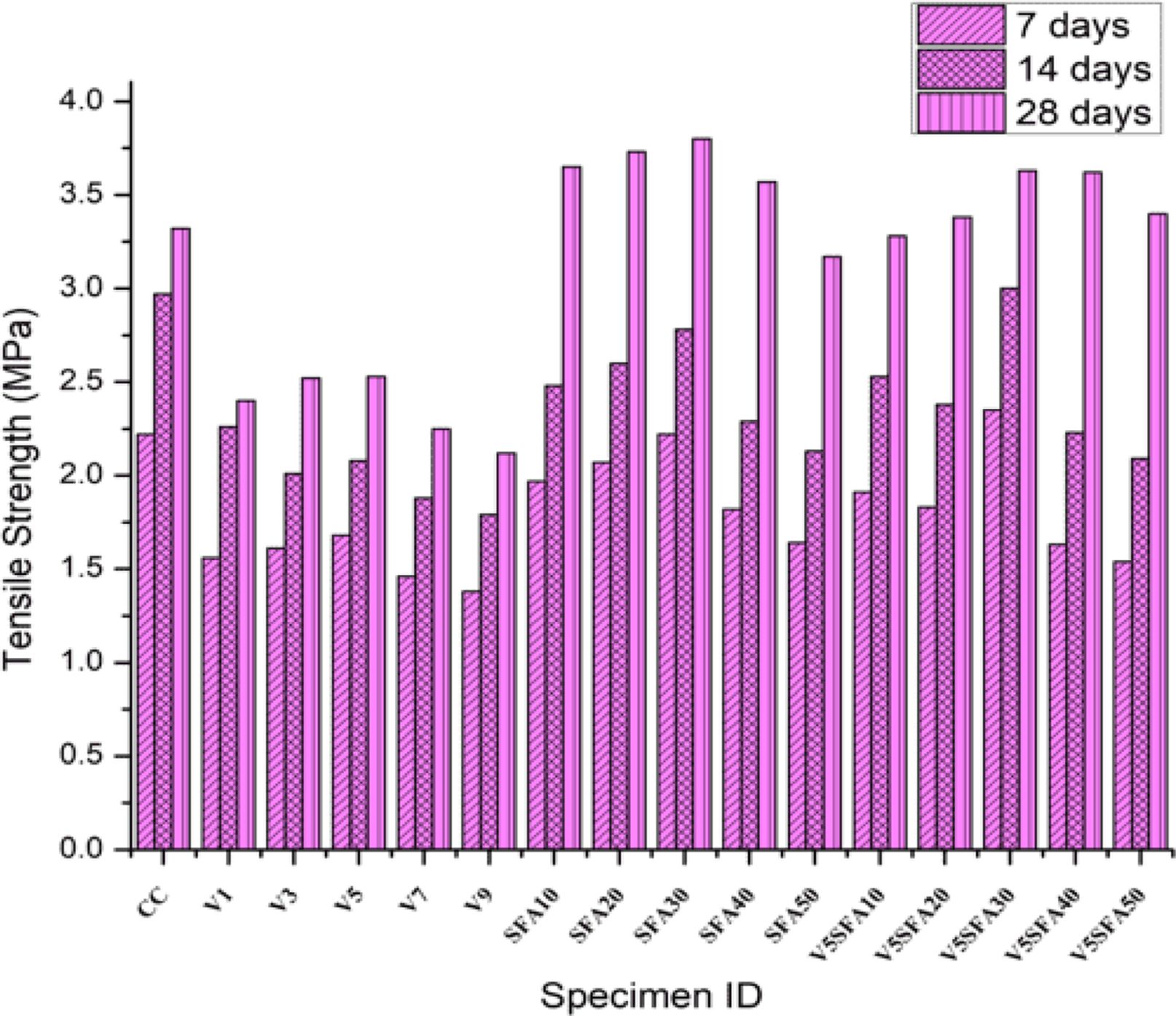
|
Fig. 9 Comparison of Tensile strength of concrete for various mixes. |

|
Fig. 10 Comparison of Flexural strength of concrete for various mixes. |
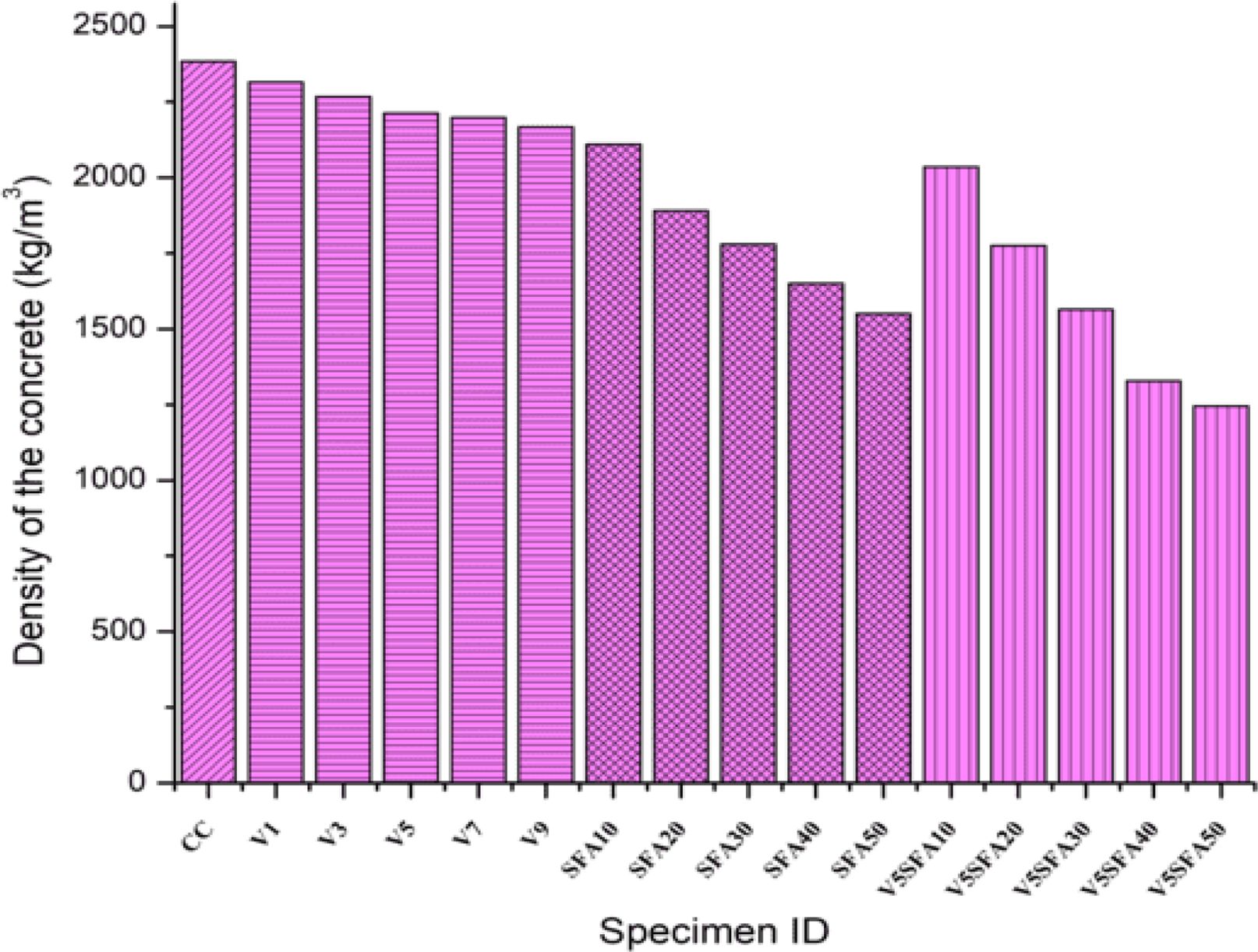
|
Fig. 11 Comparison of density of concrete for various mixes |

|
Fig. 12 Relation between compressive strength and tensile strength at 28 days. |
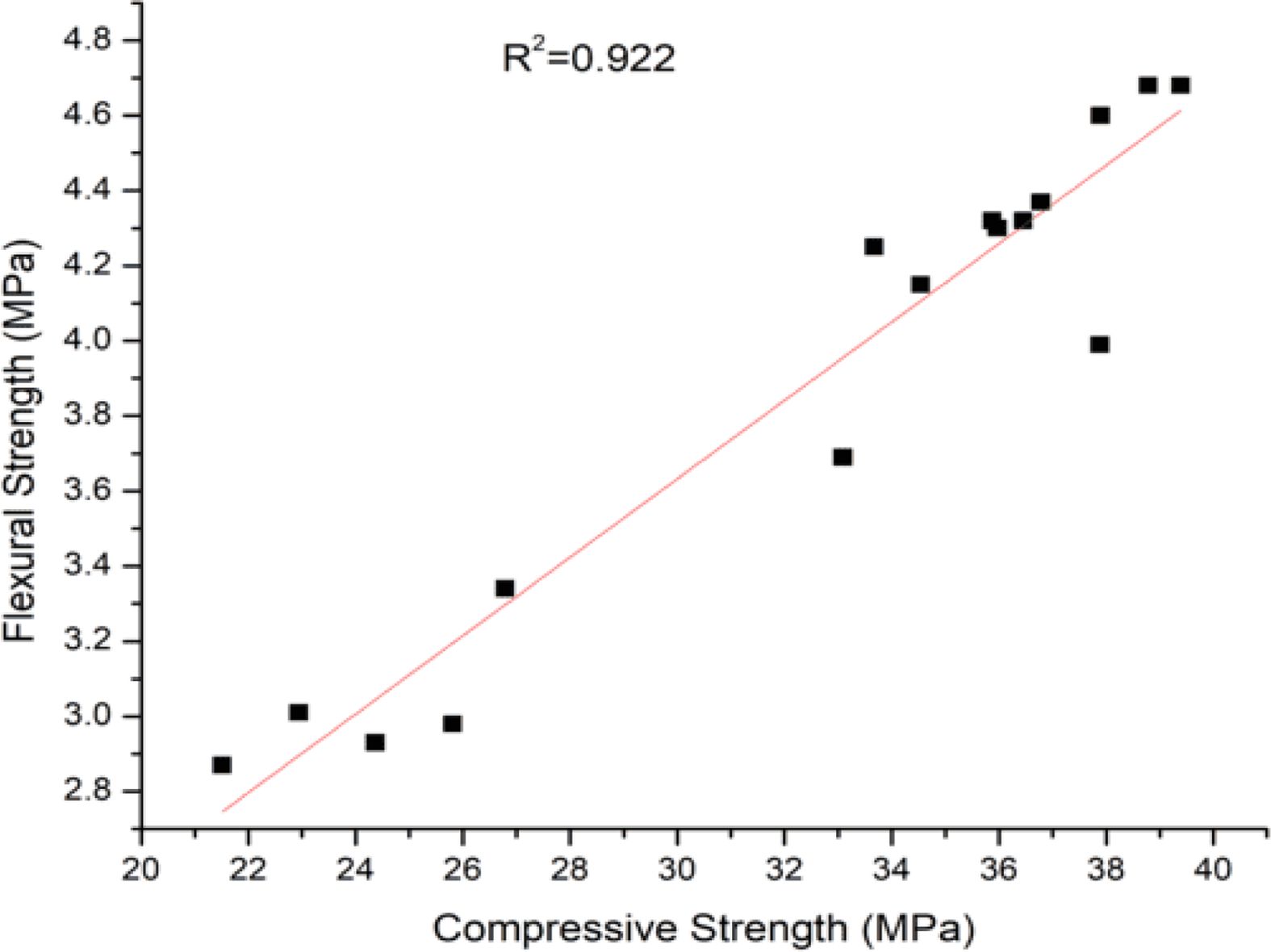
|
Fig. 13 Relation between compressive strength and flexural strength at 28 days. |
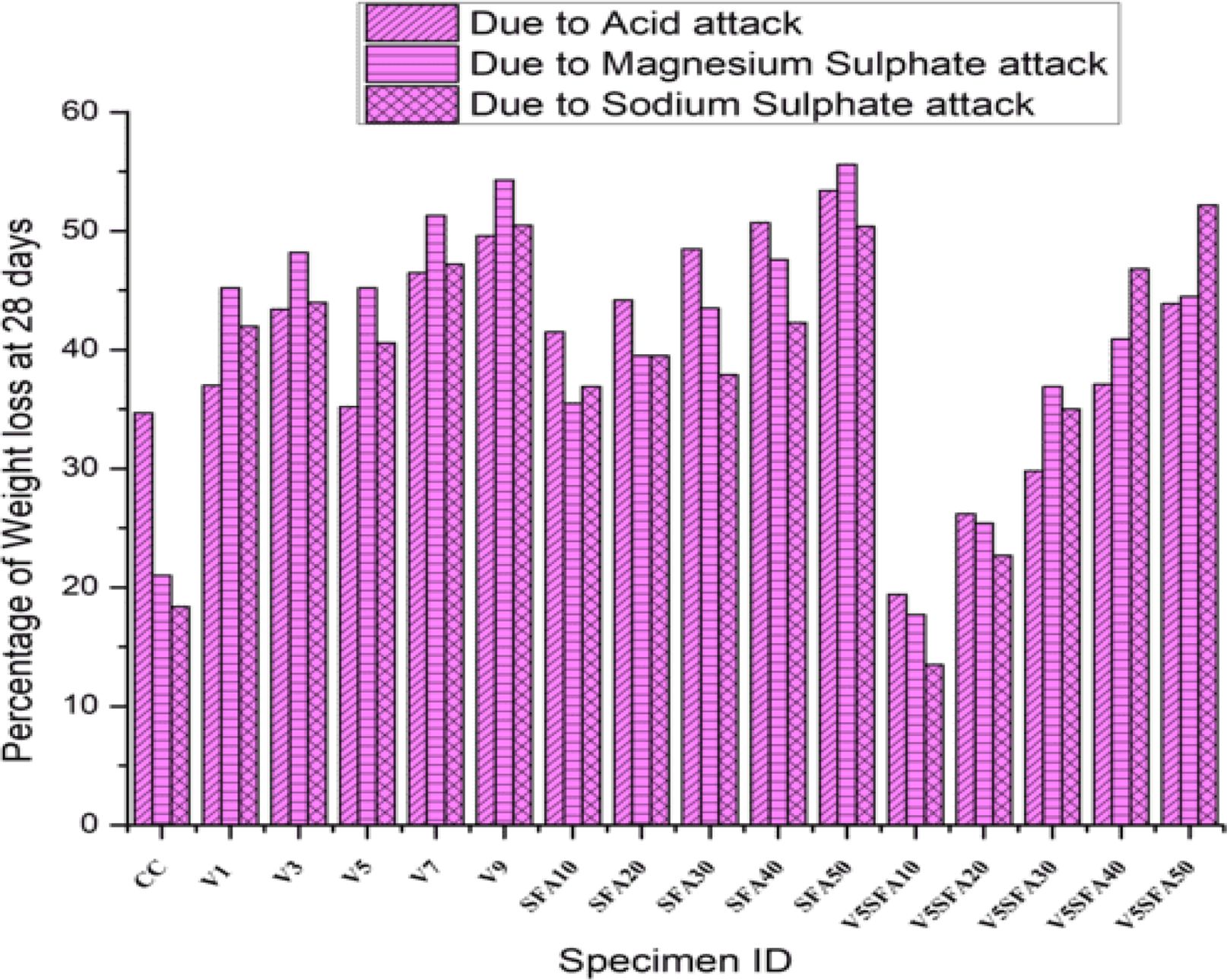
|
Fig. 14 Percentage of Weight loss due to acid and sulphate attack. |

|
Fig. 15 Percentage of Compressive strength loss due to acid and sulphate attack. |
This investigation has been carried on the properties of LWSCC with lightweight aggregates after the development of sixteen SCC mixes and following conclusions can be drawn;
• It is possible to develop light weight self compacting concrete using vermiculite and Sintered Fly Ash with optimum replacement level. All the LWSCC mixes satisfies with the EFNARC recommended values. When comparing to control concrete the LWSCC mixes shows less performance in all the fresh properties due to the microstructure of LWA containing pores and rapid water absorption characteristics. This can be balanced by increasing the dosage of superplasticizer in SCC.
• The percentage replacement of vermiculite is optimized to 5% based on the results of fresh properties of LWSCC, since it shows constant variation.
• The increase in mechanical properties of SCC is possible by using SFA with few traces of vermiculite. Vermiculite does not enhance the strength property but in future the attempt has been made to find its insulating effect due to vermiculite in LWSCC.
• The UPV test findings indicates the good quality of concrete has been possible while using light weight aggregates in SCC.
• The use of lightweight aggregates significantly increased resistance to sulphate attack. As fine aggregate is replaced with 5% of vermiculite and coarse aggregate with 30% of SFA (V5SFA30) shows magnesium sulphate attack is reduced by one-third when compared to the control mixture. SCC specimens subjected to sulphate solutions and compressive strength loss revealed that attack by magnesium sulphate is more aggressive on SCC mixes than attack by sodium sulphate.
- 1. K.A. Melo and A.M.P. Carneiro, Constr. Build. Mater. 24 (2010) 1529.
-

- 2. E.O. Ezugwu, J. Bonney, and Y. Yamane, J. Mater. Process. Technol. 134 (2003) 233.
-

- 3. H. Yazici, Constr. Build. Mater. 22 (2008) 456.
-

- 4. G.M. Glenn, A.K. Klamczynski, B.-S. Chiou, D. Wood, W.J. Orts, and S.H. Imam, J. Polym. Environ. 12 (2004) 189.
-

- 5. D. Bouvard, J.-M. Chaix, R. Dendievel, A. Fazekas, J.M. Létang, G. Peix, and D. Quenard, Cem. Concr. Res. 37 (2007) 1666.
-

- 6. Y. Xu, L. Jiang, J. Xu, and Y. Li, Constr. Build. Mater. 27 (2012) 32.
-

- 7. M. Liu, Constr. Build. Mater. 24 (2010) 1245.
-

- 8. R. Madandoust, M.M. Ranjbar, and S.Y. Mousavi, Constr. Build. Mater. 25 (2011) 3721.
-

- 9. İ. Türkmen, Mater. Lett. 57 (2003) 4560.
-

- 10. M.O.F. Mines, I. Bureau, and O.F. Mines, 2020 (2022).
- 11. B. Berge, Ecology of Building Materials (Routledge, 2007).
-

- 12. S.M.A. El-Gamal, F.S. Hashem, and M.S. Amin, J. Therm. Anal. Calorim. 109 (2012) 217.
-

- 13. L. Pérez-Maqueda, V. Balek, J. Poyato, J. Perez-Rodriquez, J. Šubrt, I. Bountsewa, I. Beckman, and Z. Málek, J. Therm. Anal. Calorim. 71 (2003) 715.
-

- 14. M.S. Nadesan and P. Dinakar, Constr. Build. Mater. 176 (2018) 665.
-

- 15. H.F.W. Taylor, Cem. Chem. 2nd Ed. Thomas Telford, London (1997).
- 16. B. Felekoǧlu, K. Tosun, B. Baradan, A. Altun, and B. Uyulgan, Cem. Concr. Res. 36 (2006) 1719.
-

- 17. IS: 12269, Bur. Indian Stand. New Delhi (2013).
- 18. IS-1727, Bur. Indian Stand. New Delhi (1967).
- 19. IS 9103, Bur. Indian Stand. Dehli 1 (1999).
- 20. S. Efnarc, London, UK Assoc. House 32 (2002) 34.
- 21. T. Patzias, Cem. Concr. Aggregates 13 (1991) 50.
-

- 22. J. Song, X. Yang, P. Chen, H. Xu, D. Luo, R. Liu, and Z. Lai, J. Ceram. Process. Res. 23 (2022) 409.
-

- 23. O.S. Park and H.K. Cho, J. Ceram. Process. Res. 23 (2022) 165.
-

- 24. H.S. Seok, J.S. Cho, K.Y. Moon, and C.W. Hong, J. Ceram. Process. Res. 22 (2021) 25.
-

- 25. P.N. Sen, C. Scala, and M.H. Cohen, Geophysics 46 (1981) 781.
-

- 26. U. Rentsennorov, B. Davaabal, B. Dovchin, and J. Temuujin, J. Ceram. Process. Res. 22 (2021) 232.
-

- 27. T.H. Wee, A.K. Suryavanshi, S.F. Wong, and A.K.M.A. Rahman, Mater. J. 97 (2000) 536.
- 28. K.M.A. Hossain and M. Lachemi, Cem. Concr. Res. 36 (2006) 1123.
-

- 29. D.D. Higgins, Cem. Concr. Compos. 25 (2003) 913.
-

- 30. M.J. Shannag, Constr. Build. Mater. 25 (2011) 658.
-

 This Article
This Article
-
2023; 24(1): 182-189
Published on Feb 28, 2023
- 10.36410/jcpr.2023.24.1.182
- Received on Sep 13, 2022
- Revised on Oct 24, 2022
- Accepted on Nov 19, 2022
 Services
Services
- Abstract
introduction
materials and methodology
results and discussion
conclusion
- References
- Full Text PDF
Shared
 Correspondence to
Correspondence to
- A. Anitha
-
Assistant Professor, Department of Civil Engineering, Velalar college of Engineering and Technology, Erode
Tel : +91-8667543289 Fax: 0424-2244205 - E-mail: anitharam.civil@gmail.com







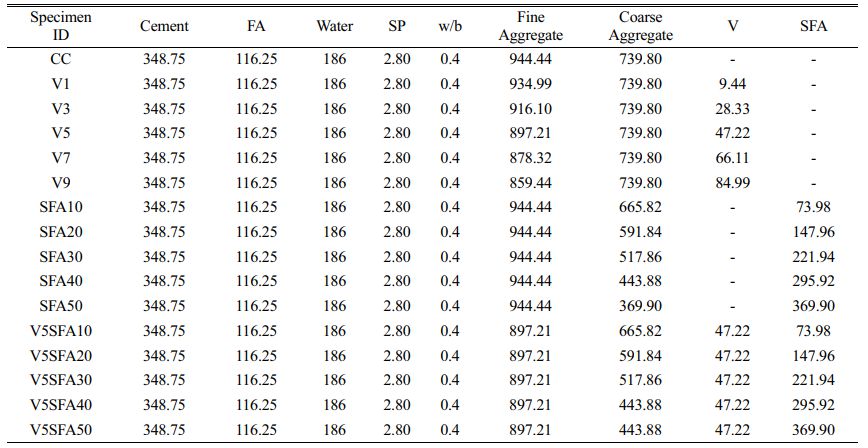



 Copyright 2019 International Orgranization for Ceramic Processing. All rights reserved.
Copyright 2019 International Orgranization for Ceramic Processing. All rights reserved.